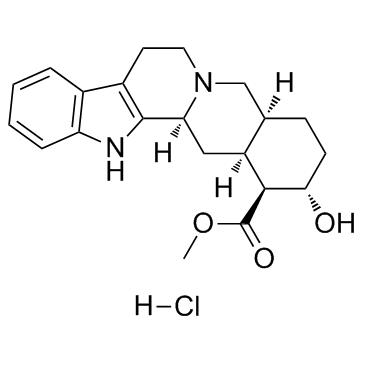Rauwolscine hydrochloride
Modify Date: 2024-01-03 17:07:14

Rauwolscine hydrochloride structure
|
Common Name | Rauwolscine hydrochloride | ||
|---|---|---|---|---|
| CAS Number | 6211-32-1 | Molecular Weight | 390.904 | |
| Density | 1.31 g/cm3 | Boiling Point | 543ºC at 760 mmHg | |
| Molecular Formula | C21H27ClN2O3 | Melting Point | 270-280ºC | |
| MSDS | N/A | Flash Point | 282.2ºC | |
Use of Rauwolscine hydrochlorideRauwolscine hydrochloride is a potent and specific α2 adrenergic receptor antagonist with a Ki of 12 nM. |
| Name | rauwolscine hydrochloride |
|---|---|
| Synonym | More Synonyms |
| Description | Rauwolscine hydrochloride is a potent and specific α2 adrenergic receptor antagonist with a Ki of 12 nM. |
|---|---|
| Related Catalog | |
| Target |
Ki: 12 nM (α2 adrenergic receptor)[1] |
| In Vitro | [3H]Rauwolscine binding to α2 adrenergic receptor is reversible, stcreospccific, and saturable. [3H]Rauwolscine specifically labels both the high and low affinity states of the α2 adrenergic receptor in brain membranes[1]. [3H]Rauwolscine also behaves as a 5-HT1A receptor agonist and this conclusion is compatible with earlier functional studies, indicating that rauwolscine (as well as yohimbine) has agonistic properties at the level of 5-HT autoreceptors[2]. When using [3H]5-HT as a radioligand, rauwolscine is determined to have relatively high affinity for the human receptor (Ki human=14.3 nM, Ki rat=35.8 nM)[3]. Saturation studies shows that the affinity of [3H]Rauwolscine is similar in mouse, rat, rabbit, dog (2.33-3.03 nM) except man where it is significantly higher (0.98 nM) [4]. |
| Kinase Assay | Fresh bovine frontal cortex is incubated in triplicate with [3H]Rauwolscine (82 Ci/mM, diluted). Incubation is terminated by filtration under reduced pressure over filters, which are then rinsed with ice cold Tris-HCl buffer, dried overnight and added to disposable glass minivials containing 3.0 mL of a 95% Econofluor/5% Protosol solution. Samples are counted by liquid scintillation spectrometry with an efficiency of 32%. (-)- [3H]Epinephrine binding to bovine cortex membranes is conducted at 25°C[1]. |
| References |
| Density | 1.31 g/cm3 |
|---|---|
| Boiling Point | 543ºC at 760 mmHg |
| Melting Point | 270-280ºC |
| Molecular Formula | C21H27ClN2O3 |
| Molecular Weight | 390.904 |
| Flash Point | 282.2ºC |
| Exact Mass | 390.171021 |
| PSA | 65.56000 |
| LogP | 3.38700 |
| Storage condition | Store at RT |
| Water Solubility | H2O: soluble |
CHEMICAL IDENTIFICATION
HEALTH HAZARD DATAACUTE TOXICITY DATA
|
| Hazard Codes | T: Toxic; |
|---|---|
| Risk Phrases | R23/24/25 |
| Safety Phrases | 22-36/37/39-45 |
| RIDADR | UN 1544 6 |
| WGK Germany | 3 |
| RTECS | ZG1035000 |
| HS Code | 29339900 |
| isoyohimbine |
| 20α-Yohimban-16β-carboxylic acid, 17α-hydroxy-, methyl ester, monohydrochloride (8CI) |
| EINECS 228-279-6 |
| rauwolscine |
| Yohimban-16-carboxylic acid, 17-hydroxy-, methyl ester, (15ξ,16β,17α,20α)-, hydrochloride (1:1) |
| Methyl (15ξ,16β,17α,20α)-17-hydroxyyohimban-16-carboxylate hydrochloride (1:1) |
| Methyl (1S,2S,4aS,13bS,14aS)-2-hydroxy-1,2,3,4,4a,5,7,8,13,13b,14,14a-dodecahydroindolo[2',3':3,4]pyrido[1,2-b]isoquinoline-1-carboxylate hydrochloride |
| Methyl-(1S,2S,4aS,13bS,14aS)-2-hydroxy-1,2,3,4,4a,5,7,8,13,13b,14,14a-dodecahydroindolo[2',3':3,4]pyrido[1,2-b]isochinolin-1-carboxylathydrochlorid |
| mesoyohimbine |
| Methyl (16β,17α,20α)-17-hydroxyyohimban-16-carboxylate hydrochloride (1:1) |
| Methyl (16β,17α,20α)-17-hydroxyyohimban-16-carboxylate hydrochloride |
| (16β,17α,20α)-17-Hydroxyyohimban-16-carboxylate de méthyle chlorhydrate |
| rauwolfscine hydrochloride |
| 20α-Yohimban-16β-carboxylic acid, 17α-hydroxy-, methyl ester, monohydrochloride |
| Methyl-(16β,17α,20α)-17-hydroxyyohimban-16-carboxylathydrochlorid |
| (1S,2S,4aS,13bS,14aS)-2-Hydroxy-1,2,3,4,4a,5,7,8,13,13b,14,14a-dodécahydroindolo[2',3':3,4]pyrido[1,2-b]isoquinoléine-1-carboxylate de méthyle chlorhydrate |
| rauwolscine hcl |
| Yohimban-16-carboxylic acid, 17-hydroxy-, methyl ester, (16β,17α,20α)-, hydrochloride (1:1) |
| Rauwolscine (hydrochloride) |

